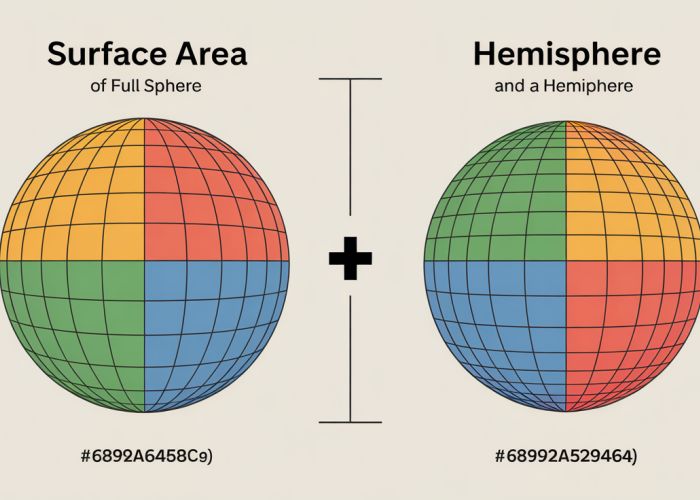The calculation of hemisphere surface area is a fundamental concept in geometry. Understanding this concept allows for accurate measurements useful in fields like architecture. The formula for hemisphere surface area, easily accessible through our free online calculator, enables precise estimations. Knowing hemisphere surface area helps in planning and design, demonstrating the value of mathematical understanding in practical applications.

Understanding Hemisphere Surface Area: A Simple Guide
This guide breaks down the concept of "hemisphere surface area" making it easy to understand and calculate. We’ll cover the necessary formulas, explain the different types of surface area for a hemisphere, and provide practical examples. Plus, we have a free calculator to help you get quick results!
What is a Hemisphere?
Before diving into "hemisphere surface area," let’s define what a hemisphere actually is. Simply put, a hemisphere is exactly half of a sphere. Imagine cutting an orange perfectly in half – each half would be a hemisphere. It has a curved surface and, in the case of a solid hemisphere, a flat, circular base.
Types of Hemisphere Surface Area
When dealing with a hemisphere, you need to understand two types of surface area:
- Curved Surface Area (CSA): This is the area of the curved part of the hemisphere only, like the peel of our halved orange.
- Total Surface Area (TSA): This includes the curved surface and the flat, circular base.
It’s crucial to differentiate between these two when solving problems related to "hemisphere surface area."
The Formulas You Need
Here are the formulas for calculating both the Curved Surface Area (CSA) and Total Surface Area (TSA) of a hemisphere:
- Curved Surface Area (CSA):
2πr² - Total Surface Area (TSA):
3πr²
Where:
π(pi) is approximately equal to 3.14159ris the radius of the hemisphere (the distance from the center of the circular base to any point on the edge).
Step-by-Step Calculation Examples
Let’s walk through a couple of examples to illustrate how to use these formulas.
Example 1: Finding the Curved Surface Area
Suppose we have a hemisphere with a radius of 5 cm. What is its curved surface area?
- Identify the radius:
r = 5 cm - Apply the CSA formula:
CSA = 2πr² - Substitute the values:
CSA = 2 * 3.14159 * (5 cm)² - Calculate:
CSA = 2 * 3.14159 * 25 cm² = 157.08 cm²
Therefore, the curved surface area of the hemisphere is approximately 157.08 square centimeters.
Example 2: Finding the Total Surface Area
Now, let’s say we have a solid hemisphere with a radius of 8 inches. What is its total surface area?
- Identify the radius:
r = 8 inches - Apply the TSA formula:
TSA = 3πr² - Substitute the values:
TSA = 3 * 3.14159 * (8 inches)² - Calculate:
TSA = 3 * 3.14159 * 64 inches² = 603.19 inches²
Therefore, the total surface area of the solid hemisphere is approximately 603.19 square inches.
Using the Free Hemisphere Surface Area Calculator
To make calculating "hemisphere surface area" even easier, we’ve provided a free online calculator! Simply enter the radius of the hemisphere, and it will instantly calculate both the Curved Surface Area and the Total Surface Area. It’s a quick and convenient way to verify your calculations or get results when you’re in a hurry.
[Note: Here you would embed the actual calculator tool if possible]
Hemisphere Surface Area: Common Mistakes to Avoid
When calculating "hemisphere surface area," watch out for these common pitfalls:
- Confusing Radius and Diameter: Remember that the radius is half the diameter. Using the diameter instead of the radius in the formulas will lead to incorrect results.
- Forgetting Units: Always include the correct units (e.g., cm², inches², m²) in your final answer.
- Mixing up CSA and TSA: Always double-check whether the problem is asking for the curved surface area or the total surface area.
Real-World Applications of Hemisphere Surface Area
Understanding "hemisphere surface area" isn’t just a theoretical exercise. It has many practical applications in various fields:
- Engineering: Calculating the surface area of dome-shaped structures.
- Architecture: Designing roofs and other architectural features.
- Manufacturing: Determining the amount of material needed to create hemispherical products.
- Science: Calculating the surface area of certain cells or spherical objects.
By mastering the concepts and formulas related to "hemisphere surface area," you’ll gain a valuable tool for solving real-world problems.
Hemisphere Surface Area FAQs
This section answers common questions about calculating hemisphere surface area and using our free calculator.
What’s the difference between total surface area and curved surface area of a hemisphere?
The curved surface area of a hemisphere is just the curved part, equaling 2πr². The total surface area includes the curved surface plus the circular base, equaling 3πr². When solving for hemisphere surface area, you’ll need to understand the difference.
How does the radius affect the hemisphere surface area calculation?
The radius (r) is the key input. Both curved (2πr²) and total (3πr²) hemisphere surface area formulas depend directly on the radius squared. A larger radius dramatically increases the surface area.
Can I use this calculator for hemispheres that are not perfectly round?
No. The hemisphere surface area formulas and this calculator are designed for perfect hemispheres. Imperfect or irregular shapes require more complex calculations or estimation methods.
What units of measurement should I use with the hemisphere surface area calculator?
The calculator is unit-agnostic. Enter the radius in any unit (cm, inches, meters, etc.). The result will be in the square of that same unit (cm², in², m², etc.) for hemisphere surface area.
So, whether you’re tackling a school project or just curious about shapes, hopefully, this guide to hemisphere surface area helped clear things up! Happy calculating!